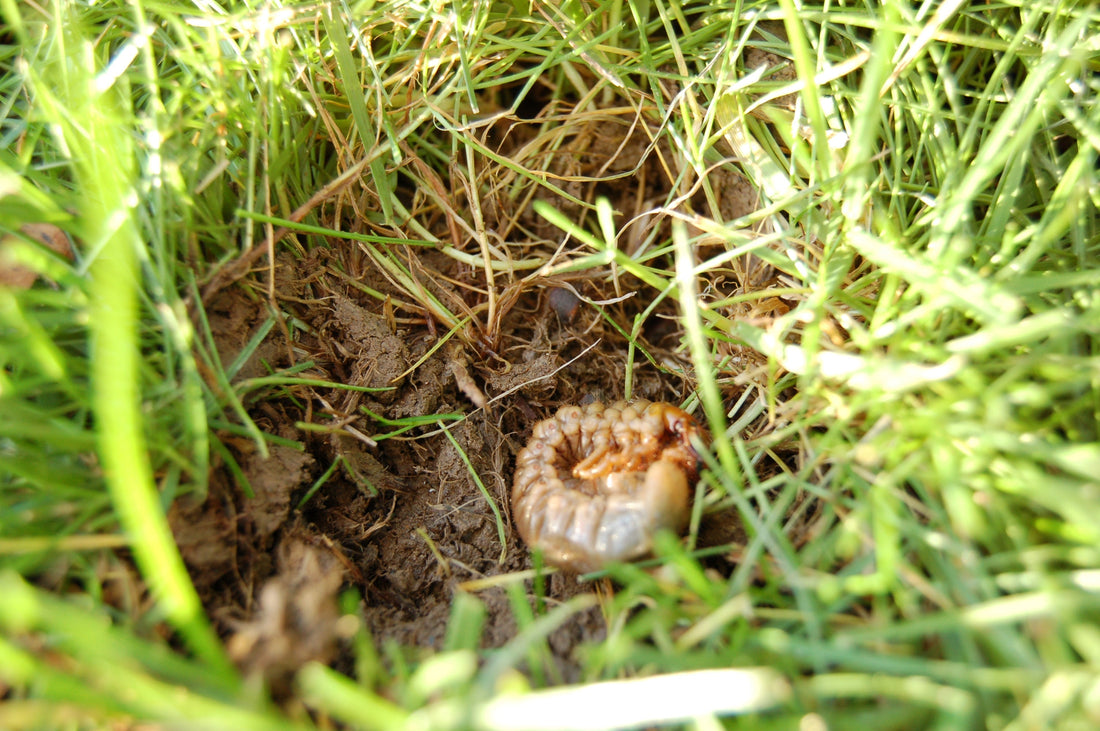Chafer Grubs can seriously compromise the health and beauty of your lawn. These small, white larvae are known to cause extensive damage to grass roots, leading to unsightly yellowy-brown patches and weak turf. This blog provides valuable insights to help you identify Chafer Grubs, recognise their impact on your lawn, explore our treatment method, and learn how to recover your lawn following an infestation.
Identifying Chafer Grubs in Your Lawn
Chafer Grubs are a common issue for lawn owners across the UK. These small, C-shaped white larvae can inflict significant damage on your lawn if not addressed.

The grubs of Chafer Beetles primarily reside in the soil beneath your lawn where they feast on grass roots. This feeding behaviour often results in patches of dead or yellowing grass that can easily be lifted, much like a loose carpet. If you observe irregular yellowy-brown patches or areas of thinning grass, it could indicate a Chafer Grub infestation in your lawn.

Identifying them is usually straightforward. If you suspect their presence, you can check by lifting a small piece of your lawn and inspecting the soil and grass roots. The grubs are typically creamy white with a distinctive C-shaped body and brown head with 3 pairs of legs alongside the head. They measure about 1 to 2 centimetres in length.
The lifecycle of Chafer Grubs begins when adult Chafer Beetles lay their eggs in the soil during early summer. These eggs hatch into small grubs that feed on grass roots through autumn and early spring. The grubs then pupate as the weather warms, transforming into adult beetles that emerge from the soil to mate and restart the cycle.
There are at least 4 species that can cause issues for a lawn, these have different lifecycles so it’s important to have regular treatments until we’re sure we’ve managed to control them.
The Adverse Impact of Chafer Grubs on Lawns
One of the most visible effects of Chafer Grubs is the weakening of the grass. As they consume the roots, the grass is stripped of essential nutrients and moisture, resulting in yellowing and thinning patches. This weakened state leaves the lawn more susceptible to stress, drought and disease.
The physical activity of Chafer Grubs can also create uneven and bumpy patches on your lawn, which can pose a hazard, especially for children playing on the grass. And Chafer Grubs attract other pests, such as birds, foxes, and badgers, which dig up lawns in search of food, causing more damage.
Chafer Grub Control: How to Deal with Chafer Grubs Effectively
Measures to implement: Preventive actions can reduce the risk of Chafer Grub infestation. Effective measures include regular mowing at the recommended height and lawn aeration to promote a robust, healthy turf. Avoiding excessive watering and removing thatch build-up can also deter these pests.
Treatment: Depending on the severity of the infestation and the lifecycle of the grubs, we offer several effective solutions:
NutraShield Pest Control Programme
As the name suggests, this shields the grass from the damage which can be caused by the pests we find in lawns in the UK. The product we use is effective at reducing the numbers of grubs in the lawn and limits damage in their next season.
BioStimulant Treatment
Our BioStimulant Pest Management Treatment supports the recovery of your grass after a pest attack. This treatment can also deter the pests from eating the plant, further reducing damage.
Your GreenThumb Lawn Operative will carefully evaluate your lawn’s condition and recommend the best treatment, or even a combination of treatments most suitable to your lawn’s needs.
Reviving Your Lawn after Chafer Grub Damage
Following a Chafer Grub infestation, your lawn may require attention to restore its health.

Start by removing any dead or damaged grass from the affected areas, using a rake to lift and clear away any debris or loose soil. Once the area is clear, proceed with reseeding or patching the bare spots using quality grass seed suitable for your lawn and micro-climate. Ensure regular watering of the newly seeded areas.
We recommend our Top Dressing and Overseeding service.
Our Top Dressing is a bespoke, 100% organic product, made up of compost. It's used for overseeding to nourish and protect developing grass plants and to enrich sandy soil or improve clay soil.
Our Diamond Green seed is a blend of Fescue and Perennial Rye grasses which adapt specifically to any environment. It’s fast at establishing, improves colour and has great tolerance to drought, shade, disease and close mowing.
Post Chafer Grub treatment lawn maintenance is crucial to prevent further damage. Regularly mow your lawn at the appropriate height for your grass type and avoid cutting it too short. Also, ensure regular watering to promote strong root growth.
Got chafer grub questions? Find your local branch here

